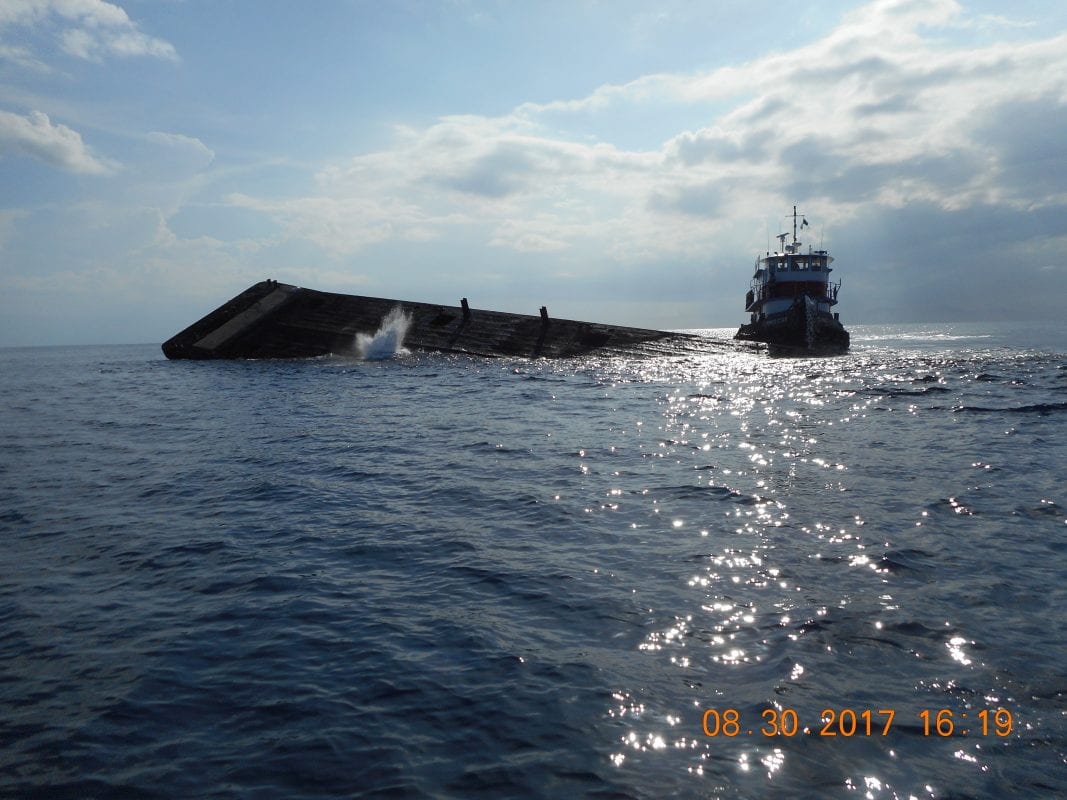The St. Lucie County Artificial Reef Program has been busy recovering from Hurricane Irma. Before the storm hit the Treasure Coast, the program had just started to fulfill the requirements of the Florida Fish and Wildlife Conservation Commission (FWC) grant FWC 17-019 by deploying the 195-foot Dixie Barge in 170 feet of water. To add to the complexity of this reef, McCulley Marine Services will attempt to deploy 1,000 tons of secondary concrete on top of the Dixie Barge.
Throughout the year, St. Lucie County has continued to collect materials from local construction projects. A diverse number of clean concrete objects, including bridge slab, bridge pilings, and reinforced concrete pipe will be added to the Dixie Barge to increase the complexity of the reef and increase the habitat availability for many different species of fish, including forage fish, juvenile fishes, and cryptic species.
Although the ability to catch fish on St. Lucie County artificial reefs is of primary importance, the ability of our artificial reefs to provide other ecological functions (places for juveniles to grow, places for adults to spawn) is important in ensuring the continued high fish production on our reefs. Juveniles of deepwater species, such as snowy grouper and red snapper have been detected on St. Lucie County artificial reefs.
The deepwater location of the Dixie Barge Reef was chosen by advisory committee members to test whether this reef can support spawning populations of deepwater species. Although large numbers of deepwater grouper species and scamp have been detected utilizing deepwater artificial reefs, the Florida Atlantic University – Harbor Branch Oceanographic Institute (FAU-HBOI), in conjunction with Last Mango Fishing Charters will be conducting an FWC-funded fisheries independent assessment of mesophotic (deepwater) artificial reef fish assemblages to determine the ecological value of these assemblages.
Hurricane Irma also impacted enhancement efforts on Moore’s Creek. For two years the St. Lucie County Artificial Reef Program has been working with the FWC’s Freshwater Wetlands Section in Okeechobee to improve the fish habitat in the creek and to improve water quality emptying into the Indian River Lagoon (IRL). Since January the FWC’s contractor, Sea & Shoreline, Inc., has been planting tapegrass in the creek. Although the tapegrass has been surviving and was starting to grow outside of the protective cages in which it was planted, Hurricane Irma displaced about half of the cages; plants inside were consumed by herbivores. The cages have been replaced and will be planted with tapegrass in the coming weeks.
Hurricane Irma showed the effectiveness of the Indian Hills Stormwater Treatment Area (STA) in cleaning stormwater being discharged into the IRL but also showed the need to create oyster reefs waterward of the outfall. Prior to being discharged into the IRL, stormwater from a 1,242-acre basin gets filtered by a 17-acre rockpit. The STA was designed to remove solids and nutrients, and to reduce turbidity entering into the IRL. Five days after Irma affected the Treasure Coast, water still flowed from the STA’s outfall. The water was stained brown with tannins (a natural chemical found in plants) but otherwise clear. Snook, schooling finger mullet and gar could be seen swimming at the outfall. Even though water quality could support the survival of these three species, the continued flow of water from this outfall was capable of scouring adjacent seagrass beds. Deploying an oyster reef waterward of this outfall will help to deflect water from the outfall and should help regenerate seagrass growth in the area.
For more information on the St. Lucie County Artificial Reef Program, potential naming opportunities for the Dixie Barge Reef, or interested in volunteering in the creation of the Indian Hills STA oyster reef, contact Jim Oppenborn, St. Lucie County Coastal Resources Coordinator, at oppenbornj@stlucieco.org or (772) 462-1713.





